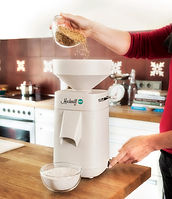STORING & MILLING
GRAINS & FLOUR
Grains such as wheat (red, white, Kamut® (Khorasan), spelt, einkorn, emmer), quinoa, amaranth, millet and other dry grains all store very well for long periods of time. If stored properly, these grains will last for years.
GENERAL STORAGE
Rotate your grains/flour - "First in, first out"
We always encourage customers to rotate their grains and flour. This is especially helpful when purchasing large quantities. Rotating your products ensures that the oldest grain or flour is used first, preventing it from going stale before you've had a chance to use it.
Grains will store for years, flour will store for months, but you should still plan on using them on a regular basis. When storing your products, label and date the container, and use the oldest grain or flour first.
How to store
If you purchase grains or flour in smaller packages, such as 1 - 5lb bags, you will probably be using them long before they would go bad. If using smaller packages within weeks or just a few months, keep the grains or flour in a food grade container.
Where to Store
When storing grains, it's always best to keep them in a cool, clean, dry, and dark environment. Light, moisture, humidity and heat will all affect grains and long-term storage in a negative way. To minimize these issues as much as possible, use a storage room, a space under the stairs, or a pantry - all are good options.

BULK STORAGE
When it comes to storing large quantities of grain and flour, the answers to the following questions are important:
Can I leave the grains in the original paper, poly, or plastic bags?
Leaving grains in their original bags is not recommended. Paper and plastic can be punctured or torn, and wear out over time. Paper and plastic are also not rodent proof. Transferring the grain to a sturdy food-grade bucket is the best choice.
What kind of container should I use?
In almost every case, storing larger amounts of grain in plastic food-grade pails is ideal. These pails can be purchased at most hardware or preparedness stores (be sure the phrase "food grade" is listed somewhere on the bucket).
The Khorasan Mills site is a good resource for purchasing quality food-grade buckets and lids.
Are rubber sealed lids important?
When storing grains long-term in food-grade pails, always use rubber-sealed lids. The rubber seal assures an air-tight fit and will keep unwanted critters out of your grain. We like a lid that does its job while also being convenient - here's a link to our favorite version, called a Gamma lid.
Should I use oxygen packets? Do oxygen packets absorb all the oxygen once the pail is sealed?
If you are storing grains for long periods of time (months/years), oxygen packets can help prolong freshness. However, most food-grade containers are not completely oxygen proof, which means that oxygen packets may not be useful long-term on their own.
Do I need to use Mylar bags? How do they help protect the grains?
Mylar bags will help prolong freshness by blocking light and helping to create a tight, cozy environment for the grains. Mylar bags must be sealed in order to be effective, which adds another step in preparing the grains for storage. Oxygen packets are optional when using Mylar bags, but when used together, Mylar bags and oxygen packets create an air-tight environment for your grains, leading to a greater shelf life.

Rubber seal, underside of lid

Gamma lid
Milling Grains
Fresh flour makes the best baked goods and offers better nutrition. When you purchase flour off the grocery store shelf, it's difficult to know how old the flour may be. You can solve that problem by milling your own grains!
A home mill will cost anywhere from around $150.00 to over $1000.00 - depending on the type you choose. There are many good mills on the market, each one unique in it's style and method for grinding grains. Our favorite is the Mockmill. This mill is top rated, is a quality product, and comes with great customer support.
Types of Mills
There are two main types of counter-top mills: Stone, and steel burr. Stone mills are very durable, and you guessed it - use stones to mill the grain. Steel burr mills use high quality steel instead of stones, and usually have life time warranties.
Mills use two stones or burrs to grind the grain. The first stone/burr (known as the bed) remains stationary while the other (known as the runner) turns and does the grinding. The stones and burrs are grooved on the inside, which forces the milled flour toward the outside of the machine to be collected in a separate container.
Stone Mills
Since the beginning of time, people have been using stones to grind their wheat. Because grains are such a basic staple in the human diet, the need to grind them more quickly became that much more important. This led to the invention of the modern electric grain mill.
For mill purists, stone mills are the more natural method for milling.

Mockmill 100

Steel Burr Mills
Mills that use steel burrs are common with the smaller, counter-top type mill you would purchase for your kitchen. The steel burrs mill grains similarly to stones, but at a much faster speed and usually at a higher temperature.
Maintenance for steel burr mills is easy and the burrs last for years.
Which mill should I consider?
There are many good mills on the market. See the following links for more information about various home grain mills.
Mockmill (German built, high quality)
KoMo (German built - high end home mill)
NutriMill (electric kitchen mill)
Wonder Mill (electric and manual options)
Blendtec (electric kitchen mill)
GrainMaker (high quality, manual mills)
Restel (high quality, stone mills)
Diagram of stone mill

Steel burrs
